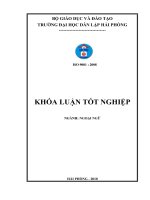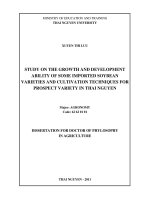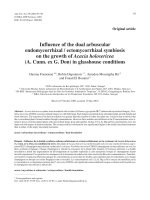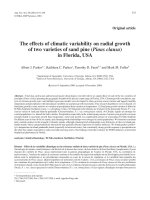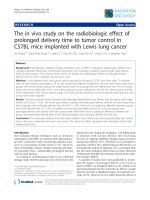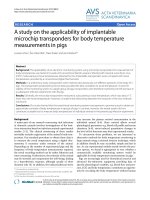Study on specified growth attributes, thermal unit requirement and its utilization efficiency in barley cultivars under varied microenvironment
Bạn đang xem bản rút gọn của tài liệu. Xem và tải ngay bản đầy đủ của tài liệu tại đây (383.94 KB, 12 trang )
Int.J.Curr.Microbiol.App.Sci (2018) 7(10): 2050-2061
International Journal of Current Microbiology and Applied Sciences
ISSN: 2319-7706 Volume 7 Number 10 (2018)
Journal homepage:
Original Research Article
/>
Study on Specified Growth Attributes, Thermal Unit Requirement and Its
Utilization Efficiency in Barley Cultivars under Varied Microenvironment
Sanu Kumar Saha*, Som Pal Singh and P.K. Kingra
Department of Climate Change and Agricultural Meteorology, Punjab Agricultural
University, Ludhiana-141004, India
*Corresponding author
ABSTRACT
Keywords
Barley, Microclimate,
AGDD, Physiological
maturity, Crop
phenology, Heat use
efficiency
Article Info
Accepted:
15 September 2018
Available Online:
10 October 2018
A field experiment was conducted during rabi 2016-17 at Research farm of Punjab
Agricultural University, Ludhiana involving two barley (Hordeum vulgare L.) varieties:
V1 (DWRUB 52, Two-rowed) and V2 (PL 807, Six-rowed) sown on three sowing dates viz.
D1 (25th October), D2 (10th November), D3 (25th November) and three irrigation levels viz.
I1 (Recommended 4 post sowing irrigation), I 2 (Skip at vegetative stage), I3 (Skip at
anthesis stage) replicated thrice in factorial split plot design to investigate heat summation
indices in relation to crop phenology under changed microclimate. Among different
sowing windows, V1 took more number of days (158) along with highest AGDD (2059.45
o
C day) to attain physiological maturity as compared to V2 (155 days and 1983.75 0C day)
under D2. Phenological models explained 94 to 99 per cent variation in crop phenology
due to heat units under three dates of sowing.V1 produced more plant height and tiller
numbers (89.26 cm and 332 per m2 respectively) than V2 whereas D2 recorded maximum
value of these attributes (91.53 cm and 362.06 per m2 respectively) followed by D1 and D3
at harvest and 90 DAS respectively. Heat use efficiency reflected positive linear
relationship with different growth components and economic yield of crop.
Introduction
Barley (Hordeum vulgare L.), a member of
Poaceae family, is now getting significant
attention worldwide due to its contribution as
food grain, feed and mating purposes. It has
covered a noticeable land masses in the
agrarian of Punjab. In Punjab, barley occupied
around 15 thousand hectares with a production
of 39.40 thousand tones and average yield of
35.82 q/ha during 2014-15 (Anonymous,
2016). Barley is a long day plant and due to
the thermo and photo sensitive nature of the
crop, solar radiation interception and thermal
use efficiency have a key role to play during
its entire life cycle. Interception of radiation
by the plant and conversion of this energy for
biomass production ultimately governs
different growth attributes (plant height, tiller
numbers, dry matter accumulation etc.) and
yield of the crop. Discrepancies in optimum
temperature both in crop vegetative and
maturity stages unfavourably affect the onset
and development of different phenophases and
grain yield of the crop. Pal et al., (2001)
suggested that seedling duration, the rate and
2050
Int.J.Curr.Microbiol.App.Sci (2018) 7(10): 2050-2061
duration of growth and productivity of the
crop can be determined by temperature, the
key
component
of
climate.
Hence,
quantification of thermal use efficiency or heat
use efficiency (the amount of dry matter
produced per unit growing degree day) is of
utmost importance in recent times for the
assessment of crop yield potential under
varying environmental conditions.
Now-a-days, temperature is raising day by day
putting immense effect on different crop
phenophases and huge fluctuations in crop
yield have been observed over years. Even,
IPCC during its fifth assessment report (2014)
mentioned globally averaged combined land
and ocean surface warming of 0.85°C during
the period from 1880 to 2012. Among
different agro-meteorological indices, GDD
(Growing Degree Days) is considered to be
the most reliable in assessing crop phenology
under changing climatic scenarios. All growth
and developmental stages of crop estimated
more accurately on the basis of GDD
(Warthington
and
Hatchinson,
2005).
Terminal heat stress, the main reason behind
reduction in grain yield due to increased
temperature conditions at crop maturity, is a
serious problem in 40 per cent of temperate
environments, which approximately covers 36
million ha. High temperatures above 30oC
affect final grain yield by reducing the
duration of grain filling. Date of sowing is one
of the important factors for higher production
as it enhances the efficiency of barley by
exploiting growth factors in an effective
manner. The crop is generally grown as
rainfed crop in Punjab, but the state is
receiving threats in the form of fast depleting
ground water resources due to climatic
variability in recent times. Thus, need based
irrigation in crucial growth stage is also
required to enhance crop productivity.
Keeping the above facts under consideration,
the present study was undertaken for
investigating variation in specified growth
parameters, thermal unit requirements and
heat use efficiency of barley under different
sowing windows, cultivars and moisture levels
in the backdrop of changed climate.
Materials and Methods
The present experiment on barley crop was
conducted at the research farm, Department of
Climate
Change
and
Agricultural
Meteorology, Punjab Agricultural University,
Ludhiana
(30°54’N
latitude,
75°56’E
longitude; altitude of 247 meters above the
mean sea level) during rabi 2016-17. The
experiment was laid out in factorial split plot
design with three replications comprising of
three sowing environments D1 (25th October),
D2 (10th November), D3 (25th November); two
varieties V1 (DWRUB 52) & V2 (PL 807) and
three irrigation levels I1 (Recommended 4 post
sowing irrigations i.e. CRI, tillering, jointing,
anthesis), I2 (Skip at vegetative stage) and I3
(Skip at anthesis stage). A set of 18 treatment
combinations were found by taking sowing
dates and varieties in main plot and irrigation
levels in sub plot. The study area is
characterized by semi-arid, sub-tropical
climate with very hot summer during AprilJune and cold winters during DecemberJanuary. This region is dominated by NW
winds during winter season and the average
annual rainfall in Ludhiana is 733mm, 75-80%
of which is received during the period from
June to September. Soil of the experimental
site was loamy sand in texture and neutral in
reaction (pH 7.5) having organic matter
content 0.28 per cent (0-15 cm surface layer).
Using the seed rate @ 35 kg per acre, seeds
were sown by ‘Kera’ method of sowing with a
row spacing of 22.5 cm. In this study,
sequential phasic development of the crop
called as crop phenology, starting from the
emergence to maturity was monitored
throughout the growing season of the crop.
Different phenological stages and days taken
2051
Int.J.Curr.Microbiol.App.Sci (2018) 7(10): 2050-2061
to complete each stage were recorded.
Periodic observations on plant height and tiller
numbers were made from 40 days afterwards
and continued till maturity. Plant height and
total tiller numbers were recorded from the
five representative plants tagged at random in
the1m row length in each plot.
maintain more accuracy. The significance of
differences was tested between treatment
means and compared using least significant
difference or critical difference (LSD or CD)
values at 5 per cent level of significance.
Regression analysis was also made to
associate grain yield with different growth
parameters and HUE.
Thermal heat unit calculation
Results and Discussion
Cumulative growing degree
determined by summing the
temperature
above
base
expressed in day °C. This was
using the following formula:
days were
daily mean
temperature,
calculated by
Tmax + Tmin
o
Tbase ( C days)
2
i=1
n
GDD =
Where,
Tmax = Daily maximum temperature (°C)
Tmin = Daily minimum temperature (°C)
Tbase = Minimum threshold/base temperature
(For barley Tbase= 5oC)
Heat Use Efficiency (HUE)
The HUE was computed to compare the
relative performance of crop under varying
environments with respect to utilization of
heat energy using the following formula:
Heat
Use
Efficiency
(g/m2/0C
day)
=
2
Dry matter yield (g/m )
AGDD (C day)
Statistical analysis
The data collected on all the characters in
respect of various growth and yield parameters
were statistically analyzed by using split plot
design as directed by Cheema and Singh
(1991) in statistical package CPCS-1. Another
statistical software named EDA 1.1 was also
used to analyze the data on all parameters to
Crop phenology
Crop phenology is defined in general as the
periodic events occurring in a plant’s entire
life period and how these are impacted by the
surrounding nature of the plants, variations in
the seasonal and annual climate and also
influenced by habitat factors. In the present
exploration, the crop was subjected to
different dates of sowing, variations in
cultivars and irrigation regimes. In the present
study, different phenophases of the two barley
varieties under different sowing time have
been prescribed in Table 1 to 3. Barley crop
overcomes several phenological stages such as
emergence, CRI, tillering, jointing, flag leaf,
booting, heading, anthesis, milk stage and
finally maturity during the entire growth
period. Here, the number of days taken by the
crop for attaining different growth stages
under different dates of sowing was observed
and the AGDD (Accumulated Growing
Degree Days) value was calculated for various
growth period taking into account the climate
factor (Temperature).
For first date of sowing, V1 reached complete
emergence at 9 DAS while V2 at 7 DAS
having AGDD values of 180.65 and 145.85 0C
day respectively. V1 completed CRI and
tillering stages at 23 DAS (399.4 0C day) and
45 DAS (704.5 0C day) while V2 at 22 DAS
(385.5 0C day) and 44 DAS (693 0C day). But
both the varieties took 67 days to attain the
jointing stage with an AGDD value of 928.25
2052
Int.J.Curr.Microbiol.App.Sci (2018) 7(10): 2050-2061
0
C day. The reproductive phase of the crop
was started with the emergence of flag leaf
about 91 DAS for V1 and 89 DAS for V2 with
AGDD values of 1118.1 0C day and 1098.1 0C
day respectively. From flag leaf emergence to
maturity, the crop covered booting, heading,
anthesis and milking stages at around 99 DAS
(1198.8 0C day), 105 DAS (1261.4 0C day),
121 DAS (1455.5 0C day) and 133 DAS
(1607.1 0C day) for V1 whereas for V2 at 98
DAS (1188.9 0C day), 104 DAS (1252.8 0C
day), 119 DAS (1432.7 0C day) and 133 DAS
(1569.1 0C day) respectively. V1 took overall
154 days while V2 required 151 days from
sowing to physiological maturity with AGDD
values of 1917.7 and 1854.7 0C day
respectively.
For second date of sowing, V1 attained
complete emergence at 10 DAS while V2 at 9
DAS having AGDD values of 165.05 and
149.65 0C day respectively. V1 completed CRI
and tillering stages at 24 DAS (364.25 0C day)
and 45 DAS (590.7 0C day) while V2 at 23
DAS (351.95 0C day) and 45 DAS (590.7 0C
day). But both the varieties took 66 days to
reach the jointing stage with an AGDD value
of 771.55 0C day. The reproductive phase of
the crop was started with the initiation of flag
leaf about 91 DAS for V1 and 89 DAS for V2
with AGDD values of 1002.55 0C day and
983.65 0C day respectively.
From flag leaf emergence to maturity, the crop
covered booting, heading, anthesis and
milking stages at around 102 DAS (1141.35
0
C day), 109 DAS (1225.25 0C day), 122 DAS
(1378.65 0C day) and 137 DAS (1617.45 0C
day) for V1 whereas for V2 at 100 DAS
(1108.15 0C day), 107 DAS (1200.35 0C day),
121 DAS (1369.45 0C day) and 136 DAS
(1596.35 0C day) respectively. V1 required
overall 158 days while V2 took 155 days from
sowing to physiological maturity with AGDD
values of 2059.45 and 1983.75 0C day
respectively.
For third date of sowing, V1 attained complete
emergence at 12 DAS while V2 at 11 DAS
having AGDD values of 176.7 and 163.8 0C
day respectively. Among the vegetative
stages, V1 completed CRI and tillering at 25
DAS (313 0C day) and 47 DAS (521.65 0C
day) while V2 at 24 DAS (302.6 0C day) and
46 DAS (517.55 0C day). But both the
varieties took 66 days to reach the jointing
stage with an AGDD value of 675.1 0C day.
The reproductive phase of the crop was started
with the initiation of flag leaf about 89 DAS
for V1 and 86 DAS for V2 with AGDD values
of 939.8 0C day and 898.9 0C day respectively.
From flag leaf emergence to maturity, the crop
covered booting, heading, anthesis and
milking stages at around 98 DAS (1052.5 0C
day), 102 DAS (1102.8 0C day), 111 DAS
(1196.5 0C day) and 123 DAS (1413.4 0C day)
for V1 whereas for V2 at 96 DAS (1025.8 0C
day), 101 DAS (1089.4 0C day), 110 DAS
(1184.6 0C day) and 122 DAS (1390.9 0C day)
respectively. V1 comprised of 142 days while
V2 took 139 days from sowing to
physiological maturity with AGDD values of
1832.9 and 1757.2 0C day respectively.
The variation in reaching different growth
stages at different time is mainly due to the
varietal difference as a two-rowed variety was
taken against of a six-rowed barley variety and
two
might
hold
different
growth
th
characteristics pattern. In case of 25 Nov.
sown crop AGDD requirement for emergence
was increased for both the varieties as
compared to 25th Oct. and 10th Nov. sown
crops due to increase in the number of days
needed as the third date of sowing fell under
relatively colder ambience as against of the
first two dates of sowing. Complete
emergence for both the cultivars took more
number of days in case of D3 rather than D1
and D2 may be due to lessen soil temperature
during the later half of November. Although
the number of days to attain different
vegetative phases remained almost similar for
2053
Int.J.Curr.Microbiol.App.Sci (2018) 7(10): 2050-2061
all dates of sowing but significant variation
has been observed in case of reproductive and
ripening stages of the crop due to late
planting. The crop sown on 25th Nov. matured
much earlier as compared to other sowing
dates because of the increased temperature
during the later stages of crop growth which
hastened the crop maturity although the period
of vegetative stages remained almost similar
with that of D1 and D2. Both V1 and V2
recorded highest AGDD during second date of
sowing followed by D1 and D2. Sharma et al.,
(2007) recorded lower thermal heat units
under late sown conditions. Alam et al.,
(2005) from Bangladesh reported that first
fortnight of November is the optimum time for
sowing of the barley. Mani et al., (2007)
reported that 10th November sown barley crop
consumed more heat unit than other dates of
sowing. Regression analysis between number
of days taken to attain different development
stages and AGDD under three dates of sowing
were given in Figure 1.
Growth parameter and economic yield
Plant height
The data pertaining to the periodic plant
height of barley was recorded under different
sowing dates, varieties and irrigation levels
throughout the rabi crop season 2016-17 have
been presented in Table 4. In early growth
phases (up to 60 days), plant height was
relatively shorter but with the passing days
toward maturity the height seemed to increase.
Plant height was affected by different dates of
sowing. The November 10 (D2) sown crop
produced significantly more plant height than
the October 25 (D1) and November 25 (D3)
sown crop under 90, 105, 120 and 135 days
after sowing. The maximum plant height
(91.53 cm) was observed during harvesting for
D2 followed by D1 (89.55 cm) and D3 (85.05
cm). The plant height of D2 was statistically at
par with that of D1 to some extent although
had significantly higher value than D3. The
crop which was sown at proper time
accomplished maximum plant height as
against of late planting and barley crop prefers
relatively cool climate for normal sowing. The
plant height at harvest of 16th October sown
crop was the highest which was statistically at
par with 15th November but significantly
higher than 15th December sown crop (Pankaj
et al., 2015). Alam et al., (2007) reported
significant reduction in plant height due to
delay in sowing. Among the two varieties (V1
and V2) used in the experiment, V1 produced
significantly more plant height than V2 during
the entire life cycle of the plant.
The maximum plant height (89.26 cm) was
recorded at maturity under V1 than that of V2
(88.16cm). Although for most of the growing
season plant height for V1 remained
significantly better than that of V2, yet the
values were statistically non-significant at 60,
75 and 105 days after sowing. Varietal
differences for plant height were also reported
by Sardana and Zhang (2004). Musavi et al.,
(2012) found highest plant height and ear
length achieved in Binam cultivar but the
highest of peduncle length and flag leaf length
related to Nosrat cultivar. Irrigation treatments
did not show much significant effect on plant
height. The variations in plant height under
different
irrigation
treatments
were
statistically non-significant at 45, 60, 90, 105,
120, 135 days after sowing while the values of
plant height were statistically significant at 75
days after sowing and during crop harvest
having slightly higher value (89.59 cm) of
plant height was observed under I2 followed
by I1 (88.66 cm) and I3 (87.88 cm).
Tiller numbers
The data regarding the number of tillers of
barley under different sowing time, varieties
and various irrigation levels have been
presented in Table 4.
2054
Int.J.Curr.Microbiol.App.Sci (2018) 7(10): 2050-2061
Table.1 Crop phenological stages and calculated thermal units (0C day) of the two barley
varieties under 25th October sown crop
V1 (DWRUB 52)
Phenophases
Sowing
Emergence
Complete Emergence
CRI
Tillering
Jointing
Flag leaf emergence
Booting
Heading
Anthesis
Milking
Physiological Maturity
Days Taken
0
4
9
23
45
67
91
99
105
121
133
154
V2 (PL 807)
AGDD (oC day)
19.3
93.9
180.65
399.4
704.5
928.25
1118.1
1198.8
1261.4
1455.5
1607.1
1917.7
Phenophases
Sowing
Emergence
Complete Emergence
CRI
Tillering
Jointing
Flag leaf emergence
Booting
Heading
Anthesis
Milking
Physiological Maturity
Days Taken
0
4
7
22
44
67
89
98
104
119
130
151
AGDD (oC day)
19.3
93.9
145.85
385.5
693
928.25
1098.1
1188.9
1252.8
1432.7
1569.1
1854.7
Table.2 Crop phenological stages and calculated thermal units (0C day) of the two barley
varieties under 10th November sown crop
V1 (DWRUB 52)
Phenophases
Sowing
Emergence
Complete emergence
CRI
Tillering
Jointing
Flag leaf
Booting
Heading
Anthesis
Milking
Physiological
Maturity
Days taken
0
6
10
24
45
66
91
102
109
122
137
158
V2 (PL 807)
AGDD (oC day)
15.8
107.75
165.05
364.25
590.7
771.55
1002.55
1141.35
1225.25
1378.65
1617.45
2059.45
Phenophases
Sowing
Emergence
Complete emergence
CRI
Tillering
Jointing
Flag leaf
Booting
Heading
Anthesis
Milking
Physiological
Maturity
Days taken
0
5
9
23
45
66
89
100
107
121
136
155
AGDD (oC day)
15.8
94.35
149.65
351.95
590.7
771.55
983.65
1108.15
1200.35
1369.45
1596.35
1983.75
Table.3 Crop phenological stages and calculated thermal units (0C day) of the two barley
varieties under 25th November sown crop
V1 (DWRUB 52)
V2 (PL 807)
Phenophases
Days taken
AGDD (oC day)
Phenophases
Days taken
Sowing
Emergence
Complete
emergence
CRI
Tillering
Jointing
Flag leaf
Booting
Heading
Anthesis
Milking
Physiological
Maturity
0
7
12
14.5
112.6
176.7
Sowing
Emergence
Complete emergence
0
7
11
AGDD (oC
day)
14.5
112.6
163.8
25
47
66
89
98
102
111
123
142
313
521.65
675.1
939.8
1052.5
1102.8
1196.5
1413.4
1832.9
CRI
Tillering
Jointing
Flag leaf
Booting
Heading
Anthesis
Milking
Physiological
Maturity
24
46
66
86
96
101
110
122
139
302.6
517.55
675.1
898.9
1025.8
1089.4
1184.6
1390.9
1757.2
2055
Int.J.Curr.Microbiol.App.Sci (2018) 7(10): 2050-2061
Table.4 Variation in plant height and tiller numbers as influenced by sowing dates, cultivars and
irrigation levels
Treatments
40 DAS
60 DAS
*Pl. *Tiller
Pl.
height count height
Sowing time
34.05
D1
36.34
D2
31.61
D3
CD (p=0.05)
0.70
Variety
34.61
V1
33.39
V2
CD (p=0.05)
0.60
Irrigation level
34.56
I1
33.47
I2
33.97
I3
CD (p=0.05)
NS
90 DAS
120 DAS
At Harvest
Tiller
count
Pl.
height
Tiller
count
Pl.
height
Tiller
count
Pl.
height
Tiller
count
252.83
269.83
208.94
4.64
58.64
60.71
56.87
2.00
280.22
297.00
233.78
5.08
78.48
82.43
76.29
1.31
335.22
362.06
281.72
3.94
85.47
88.21
82.13
1.28
322.56
352.78
278.61
4.61
89.55
91.53
85.05
0.93
313.56
343.22
269.50
5.23
274.07
266.59
4.04
58.91
58.58
NS
274.07
266.59
4.15
69.97
69.23
NS
332.00
320.67
3.22
85.95
84.59
1.04
323.41
312.56
3.77
89.26
88.16
0.76
313.56
303.96
4.27
242.61
244.44
244.56
NS
58.71
58.93
58.58
NS
273.89
267.89
269.22
3.70
68.93
70.61
69.26
1.20
337.33
319.83
321.83
3.62
85.43
85.84
84.54
NS
328.78
310.50
314.67
3.41
88.66
89.59
87.88
0.90
318.89
301.72
305.67
3.32
*Pl. height measured in cm & tiller count measured per square meter
Table.5 Variation in heat use efficiency of barley under different sowing windows, cultivars and
moisture level
Treatments
Date of Sowing
D1 (25th Oct.)
D2 (10th Nov.)
D3 (25th Nov.)
CD (p=0.05)
Variety
V1 (DWRUB 52)
V2(PL 807)
CD (p=0.05)
Irrigation levels
I1 (Recommended)
I2 (Skip at veg.
stage)
I3 (Skip at anthesis
stage)
CD (p=0.05)
Days after sowing (DAS)
30
60
90
120
0.34
0.66
1.71
1.31
0.36
0.73
1.72
1.35
0.32
0.59
1.46
1.16
0.01
0.03
0.01
0.02
*HUE (g/m2/oC day)
Straw
Grain
0.69
0.26
0.64
0.27
0.48
0.23
0.03
0.01
Grain yield
(kg/ha)
4249
4531
3795
102.3
0.36
0.32
0.02
0.69
0.62
0.04
1.65
1.60
0.01
1.30
1.25
0.02
0.63
0.57
0.03
0.26
0.25
0.01
4290
4094
78.37
0.34
0.35
0.67
0.68
1.63
1.67
1.27
1.28
0.61
0.61
0.26
0.25
4267
4110
0.33
0.64
1.58
1.26
0.29
0.25
4198
NS
NS
0.02
NS
NS
NS
74.09
* HUE denotes heat use efficiency
2056
Int.J.Curr.Microbiol.App.Sci (2018) 7(10): 2050-2061
Fig.1 Relationship between the number of days taken to attain different crop phonological stages
and AGDD for 25th Oct. (a-b), 10th Nov. (c-d), 25th Nov. (e-f) barley varieties
V2
y = 11.31x - 0.58
R² = 0.98
AGDD (0 C day)
2000
1500
1000
500
0
(f)
2057
0
50 DAS 100
150
Int.J.Curr.Microbiol.App.Sci (2018) 7(10): 2050-2061
Fig.2 Relationship of grain yield with specified growth parameters and
heat use efficiencies of barley
Tillering is very important as it enables the
plant to produce multiple stems leading to the
formation of dense fruits and numerous seed
heads. Periodic observations of tiller count at
45, 60, 90, 120 DAS and during harvesting
were taken from the field under different
treatments. The November 10 (D2) sown crop
produced significantly more number of tillers
than October 25 (D1) and November 25 (D3)
sown crop throughout the crop season. D2
recorded maximum tiller count (362.06 per
m2) at 90 DAS followed by D1 (335.22 per
m2) and D3 (281.72 per m2). It was also
observed that the tiller numbers of D2 was
statistically at par with D1 but having
significantly higher value than D3. D1 also
had much higher tiller count as compared to
D3. Singh et al., (1997) recorded significantly
higher plant height (91.6 cm) and number of
tillers/meter row length (132.5) in oats sown
on 6th November compared to plant heights
of 87.5 and 81.2 cm and tillers per meter row
length (129.1 and 118.2) when sown on 22nd
October and 21st November, respectively.
Significant differences in tiller count were
observed among the two varieties during the
entire crop growing period. V1 produced
maximum number of tillers (332.00 per m2)
as against of V2 (320.67 per m2) at 90 days
after sowing and thereafter slight decrease in
the tiller numbers were noticed as both the
2058
Int.J.Curr.Microbiol.App.Sci (2018) 7(10): 2050-2061
cultivars progresses towards maturity. On the
contrary, Rashid et al., (2010) reported that
number of tillers per plant was found nonsignificant with sowing date.
Irrigation treatments seemed to influence the
crop tiller count significantly during
maximum growth period except from sowing
to 45 DAS. Of the three irrigation levels, I1
attained higher tiller count as compared to I2
and I3; I2 remained statistically almost at par
with I3 during the crop life period.
Grain yield
The data pertaining to the grain yield
impacted by the different sowing dates,
varieties and irrigation treatments have been
demonstrated in Table 5. The highest grain
yield (4531 kg/ha) was observed under
second date of sowing (D2) followed by D1
(4249 kg/ha) and D3 (3795 kg/ha). It was also
seen that D2 produced grain yield almost at
par with D1 but significantly much higher
than that of D3. Significant difference in the
value of grain yield was also recorded
between D1 and D3; D1 had much higher grain
yield than D3. D2 showed maximum grain
yield may be due to higher dry matter
production, highest number of effective tiller,
ear length, more 1000 seed weight and none
the less prolonged phenophases as compared
to late planting. Mani et al., (2006)
recommended that late planting of barley
beyond 10th November outcome a significant
reduction in grain yield. Similar results were
obtained by Hari Ram et al., (2010).
Of the two varieties, V1 recorded maximum
grain yield of 4290 kg/ha as compared to V2
which was found as 4094 kg/ha. The data
designated that V1 was significantly better
than V2 in reference to grain yield. Irrigation
seemed to have significant effect on grain
yield under all 3 irrigation levels (I1, I2, I3). I1
produced average higher grain yield than I2
and I3 which were statistically at par
eventually. Musavi et al., (2012) reported that
cultivar had significant influence on peduncle
length, ear length, lodging percentage and
seed yield.
Heat use efficiency
Heat use efficiency (HUE) is important factor
in crop development. The heat use efficiency
is influenced by dry matter production. In the
present study, measurement of heat use
efficiency (HUE) started from 30 days after
sowing and thereby continued at monthly
interval up to crop harvesting as showed in
Table 5. Heat use efficiency gradually
increased till 90 DAS (milk stage) and
thereby decreased toward physiological
maturity under all three sowing dates. Grain
HUE of barley was found higher in case of
second date of sowing; D2 (0.27 g/m2/oC day)
as compared to D1 and D3. But for straw HUE,
maximum value was found under D1 (0.69
g/m2/oC day) followed by D2 and D3. This
was mainly due to accumulation of more
amount of dry matter and thermal time in case
of D2 followed by D1 and D3. The delayed
sowing significantly reduces the heat unit
consumption and thermal use efficiency of the
crop as suggested by Kaur and Pannu (2008).
Kumari et al., (2009) also mentioned that
timely sowing of wheat crop seems to be
essential for harnessing heat use efficiently
under changing environmental conditions.
Heat use efficiencies for both the varieties
were found significantly different throughout
the crop period and V1 recorded both straw
and grain HUE maximum (0.63 & 0.26
g/m2/oC day) as compared to V2. The value of
heat use efficiency was more for V1 than that
of V2 because of higher amount dry matter
production under V1. Irrigation treatments did
not put any significant influence on the heat
use efficiency of the crop. However, I1
recorded relatively higher grain heat use
efficiency value followed by I2 and I3 which
2059
Int.J.Curr.Microbiol.App.Sci (2018) 7(10): 2050-2061
were similar among themselves might be due
to more availability of water in case of I1 than
other irrigation treatments.
Yield response of barley
parameters and HUE
to
growth
Regression analysis was done by fitting linear
response function between grain yield and
different growth parameters (Maximum plant
height at harvest and maximum tiller count at
90 DAS) and straw and grain heat use
efficiency (Fig. 2). Both max. Tiller count and
plant height linear regression equation with
grain yield showed positive correlation which
explained 91.81 per cent and 93.09 per cent
variability under different sowing dates,
cultivars and moisture regimes. Heat use
efficiency with respect to both straw and grain
showed positive association having 67.28 per
cent and 53.81 per cent variation with grain
yield under modified microenvironment.
Acknowledgements
The authors are highly thankful to Indian
Council of Agricultural Research, New Delhi,
Govt. of India, for providing grant in the form
of Junior Research Fellowship to conduct this
study at the research farm of Department of
Climate
Change
and
Agriculture
Meteorology, PAU, Ludhiana.
References
Alam, M. Z., Haider, S. A. and Paul, N. K.
2005. Effects of sowing time and
nitrogen fertilizer on barley (Hordeum
vulgare L.) Bangladesh J Bot.34: 27-30.
Alam, M. Z., Haider, S. A., and Paul N. K.
2007. Yield and yield components of
barley (Hordeum vulgare L.) in relation
to sowing times. Journal of Bioscience.15:139-145.
Anonymous, 2016. Package of Practices for
rabi Crops of Punjab. Punjab
Agricultural University, Ludhiana, pp.
21-24.
Cheema, H. S. and Singh, B. 1991. Software
statistical package CPCS-1. Department
of Statistics, Punjab Agriculture
University, Ludhiana.
Hari Ram., Singh, B. and Sharma, A. 2010.
Effect of sowing on the field
performance of barley (Hordeum
vulgare L.) in Punjab. J Res Punjab
agric Univ. 47: 132-35.
IPCC, 2014. 5thAssessment Report: Threat
from global warming heightened in
latest
U.N.
Report.
Geneva,
Switzerland.
Kaur, A. and Pannu, R.K. 2008. Effect of
sowing time and nitrogen schedules on
phenology, yield and thermal-use
efficiency of wheat (Triticum aestivum
L.). Indian J Agric Sci. 78: 366-69.
Kumari, P., Wadood, A., Singh, R.S. and
Kumar, R. 2009. Response of wheat
crop to different hydrothermal regimes
under the agroclimatic conditions of
Jharkhand. J Agromet. 11: 85-88.
Mani, J. K., Singh, R. and Singh, D. 2007.
Study on agrometeorological indices for
barley crop under different growing
environments. J. Agromet. 9(1): 86-91.
Mani, J. K., Singh, R., Singh, D., Pannu, R.
K. and Singh, K. 2006. Effect of sowing
dates and row spacings on yield and
yield attributes of barley. Haryana J
Agron. 22: 129-31.
Musavi, M., Soleymani, A. and Shams, M.
2012. Effect of Cultivars and Nitrogen
on Growth and Morphological Traits of
Barley inIsfahan Region. International
Journal of Agriculture and Crop
Sciences. 4-22: 1641-43.
Pal, S. K., Verma, U. N., Singh, M. K.,
Upsani, R. R. and Thakur, R. 2001.
Growth and yield of late sown wheat
under different irrigation schedules.
Indian J Agric Sci.71: 664-67.
Pankaj, S. C., Sharma, P. K., Chouksey, H. D.
2060
Int.J.Curr.Microbiol.App.Sci (2018) 7(10): 2050-2061
and Singh S. K. 2015. Growth and
development pattern of barley varieties
influenced by date of sowing and
nitrogen levels. J Bioscan. 10: 12991302.
Rashid, A. Khan. R.U., Marwat, S.K. and Ali,
Z. 2010. Response of barley to sowing
date and fertilizer application under
rainfed condition. World Journal of
Agricultural Science. 6(5): 480-484.
Sardana, V. and Zhang, G. P. 2004. Effect of
time of N application ofgrowth and
yield of barley (Hordeum vulgare L.)
cultivars.
Cereal
Res.
Communication.103:1.
Sharma, K. D., Pannu, R. K. and Behl, R. K.
2007. Effect of early and terminal heat
stress
on
biomass
partitioning,
chlorophyll stability and yield of
different wheat genotypes. Proc: The
international conference on sustainable
crop production in stress environment:
Management and genetic options. Pp
187-94.
Agrobios
(International),
Jodhpur.
Singh, J., Rana, D. S. and Joon, R.K. 1997.
Effect of sowing time, cutting
management & phosphorus levels on
growth, fodder &grain yield of Oats.
Forage Research. 23 (1 &2): 115-17.
Warthington, C. M. and Hatchinson, C. M.
2005. Accumulated degree days as a
model to determine key development
stages and evacuate yield and quality of
potato in Northeast Florida. Proceed.
State. Hort. Soc. 118: 98-101.
How to cite this article:
Sanu Kumar Saha, Som Pal Singh and Kingra, P.K. 2018. Study on Specified Growth
Attributes, Thermal Unit Requirement and Its Utilization Efficiency in Barley Cultivars under
Varied Microenvironment. Int.J.Curr.Microbiol.App.Sci. 7(10): 2050-2061.
doi: />
2061

